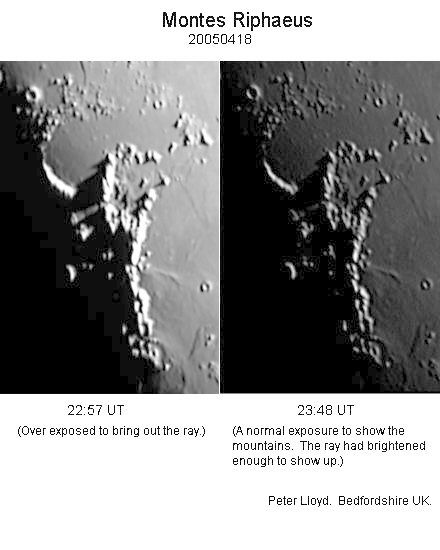Ray from Montes Riphaeus 
Move your mouse over the picture to identify the feature.

|
At sunrise and sunset on the Moon in some places the Sun shines through gaps in mountain chains
or the walls of craters, producing what is know as a ray. This is an interesting phenomenon
to observe although not of any great scientific interest. One of these gaps occurs in the Riphaeus
Mountains, which divide Mare Nubium from Oceanus Procellarum. Many of these phenomena are predicted by
The Robinson Lunar Observatory thanks to
whom I was able to catch this ray in Montes Riphaeus.
The left image was captured soon after the ray appeared and is intentionally over-exposed in order
to bring out the ray. The right-hand image was taken 50 minutes later and is more correctly exposed
to image the mountains; the ray had brightened enough in this time to show faintly.
The pictures were taken with a ToUcam attached to my LX200 on 18th April 2005 at 22:58 and 23:48 UT,
when the Moon was 9.5 days old.
These pictures have had their gamma increased to 2 (for dark monitors).
|
| Date and Time |
18th April 2005 at 22:58 and 22:48 UT |
Camera |
ToUcam 740K |
Telescope |
LX200 at prime focus |
Capture |
K3CCDTools. High gamma, 1/33", 18% gain, 303 frames
High gamma, 1/100", 32% gain, 302 frames. |
Processing |
Registax. 146 frames stacked. Wavelets 1-3 = 10. Contrast 70.
115 frames stacked. Wavelets 1-3 = 10. |
Home Back


